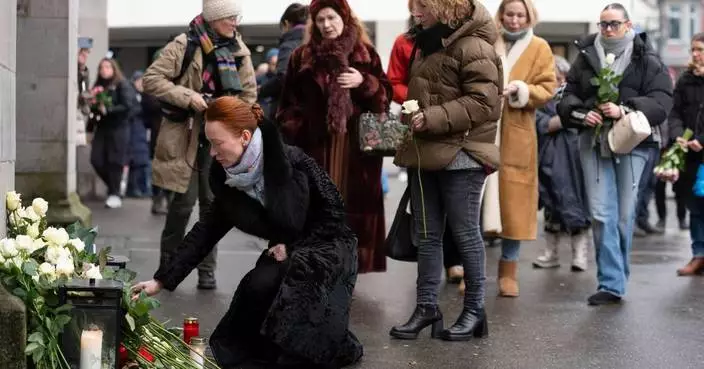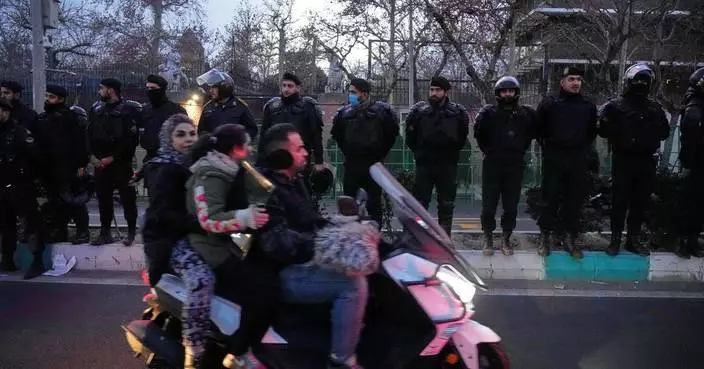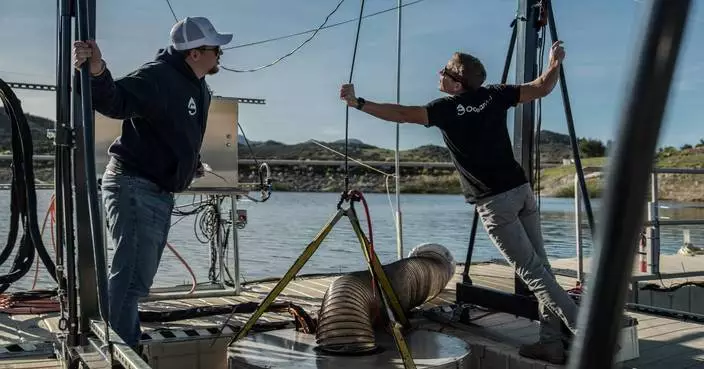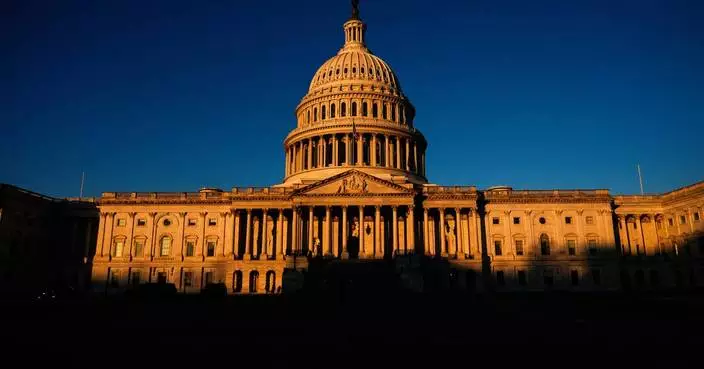The Supreme Court began its term with the tumultuous confirmation of Justice Brett Kavanaugh, followed by a studied avoidance of drama on the high court bench — especially anything that would divide the five conservatives and four liberals.
The justices have been unusually solicitous of each other in the courtroom since Kavanaugh's confirmation, and several have voiced concern that the public perceives the court as merely a political institution. Chief Justice John Roberts seems determined to lead the one Washington institution that stays above the political fray. Even Roberts' rebuke of President Donald Trump, after the president criticized a federal judge, was in defense of an independent, apolitical judiciary.
Click to Gallery
FILE - This Oct. 5, 2018, file photo shows the U. S. Supreme Court building before dawn in Washington. The Supreme Court term has steered clear of drama since the tumultuous confirmation of Justice Brett Kavanaugh. The next few weeks will test whether the calm can last. (AP PhotoJ. David Ake, File)
FILE - In this Nov. 30, 2018, file photo, the justices of the U.S. Supreme Court gather for a formal group portrait at the Supreme Court Building in Washington. Seated from left: Associate Justice Stephen Breyer, Associate Justice Clarence Thomas, Chief Justice of the United States John G. Roberts, Associate Justice Ruth Bader Ginsburg and Associate Justice Samuel Alito Jr. Standing behind from left: Associate Justice Neil Gorsuch, Associate Justice Sonia Sotomayor, Associate Justice Elena Kagan and Associate Justice Brett M. Kavanaugh. The Supreme Court term has steered clear of drama since the tumultuous confirmation of Justice Brett Kavanaugh. The next few weeks will test whether the calm can last. (AP PhotoJ. Scott Applewhite, File)
FILE - In this March 28, 2018, file photo, Ashley Oleson, with the League of Women Voters of Maryland, carries signs of Maryland's districts, as nonpartisan groups against gerrymandering protest in front of the Supreme Court, in Washington. The Supreme Court term has steered clear of drama since the tumultuous confirmation of Justice Brett Kavanaugh. The next few weeks will test whether the calm can last. (AP PhotoJacquelyn Martin, File)
FILE - In this July 9, 2018, file photo a demonstrator protests in front of the Supreme Court in Washington. The Supreme Court term has steered clear of drama since the tumultuous confirmation of Justice Brett Kavanaugh. The next few weeks will test whether the calm can last. (AP PhotoCliff Owen, File )
FILE - In this Jan. 23, 2018, file photo, immigration advocates hold a rally on Capitol Hill in Washington. The Supreme Court term has steered clear of drama since the tumultuous confirmation of Justice Brett Kavanaugh. The next few weeks will test whether the calm can last. (AP PhotoAndrew Harnik, File)
The next few weeks will test whether the calm can last.
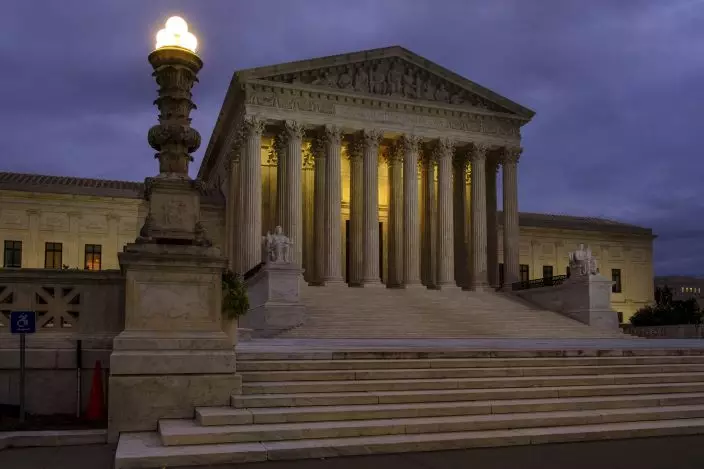
FILE - This Oct. 5, 2018, file photo shows the U. S. Supreme Court building before dawn in Washington. The Supreme Court term has steered clear of drama since the tumultuous confirmation of Justice Brett Kavanaugh. The next few weeks will test whether the calm can last. (AP PhotoJ. David Ake, File)
When they gather in private on Jan. 4 to consider new cases for arguments in April and into next term, the justices will confront a raft of high-profile appeals.
Abortion restrictions, workplace discrimination against LGBT people and partisan gerrymandering are on the agenda. Close behind are appeals from the Trump administration seeking to have the court allow it to end an Obama-era program that shields young immigrants from deportation and to put in place restrictive rules for transgender troops.
There already are signs that the conservative justices, apart from Roberts, are willing to take on controversial cases that are likely to produce the ideological and partisan divisions that their colleagues seem eager to avoid.
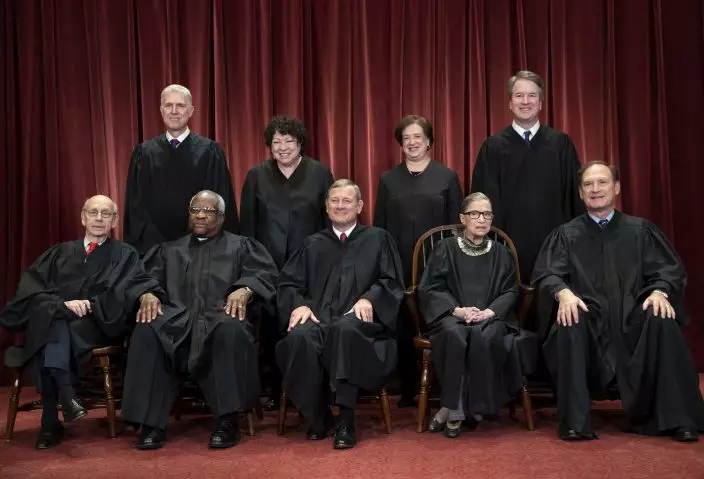
FILE - In this Nov. 30, 2018, file photo, the justices of the U.S. Supreme Court gather for a formal group portrait at the Supreme Court Building in Washington. Seated from left: Associate Justice Stephen Breyer, Associate Justice Clarence Thomas, Chief Justice of the United States John G. Roberts, Associate Justice Ruth Bader Ginsburg and Associate Justice Samuel Alito Jr. Standing behind from left: Associate Justice Neil Gorsuch, Associate Justice Sonia Sotomayor, Associate Justice Elena Kagan and Associate Justice Brett M. Kavanaugh. The Supreme Court term has steered clear of drama since the tumultuous confirmation of Justice Brett Kavanaugh. The next few weeks will test whether the calm can last. (AP PhotoJ. Scott Applewhite, File)
In recent weeks, three conservative justices accused the court of ducking its job of deciding important cases, especially when lower courts have disagreed on the outcome. Their criticism, written by Justice Clarence Thomas and joined by Justices Samuel Alito and Neil Gorsuch, came after a recent decision to avoid a case involving funding for Planned Parenthood.
Then, on the Friday before Christmas, the court divided 5-4 in refusing to allow the Trump administration to enforce new restrictions on asylum seekers. Roberts joined the four liberals. The three conservatives who were displeased by the Planned Parenthood case outcome again noted their disagreement, this time joined by Kavanaugh.
The two votes can't be used to draw any firm conclusions about what may be happening behind closed doors at the court, as the cases arrived in different circumstances. In the Planned Parenthood case, the justices were considering whether to grant full review, a process that takes only four votes. The asylum case was an emergency appeal from the administration. At least five of the nine justices would have had to vote in the administration's favor.
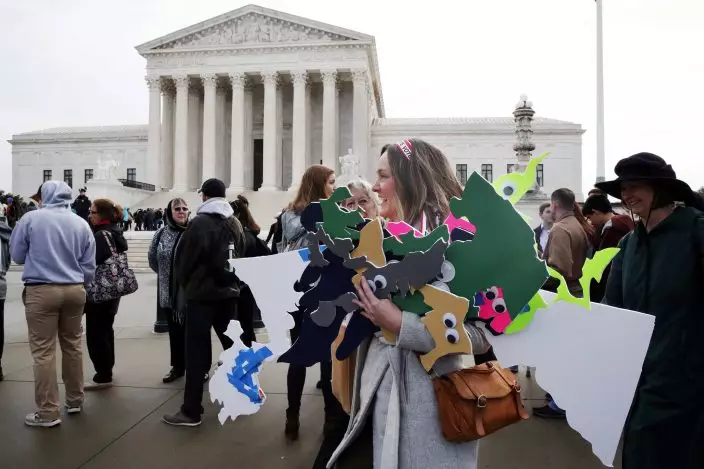
FILE - In this March 28, 2018, file photo, Ashley Oleson, with the League of Women Voters of Maryland, carries signs of Maryland's districts, as nonpartisan groups against gerrymandering protest in front of the Supreme Court, in Washington. The Supreme Court term has steered clear of drama since the tumultuous confirmation of Justice Brett Kavanaugh. The next few weeks will test whether the calm can last. (AP PhotoJacquelyn Martin, File)
But Lawrence Solum, a professor of constitutional law at Georgetown University's law school, said Roberts seems to have two reasons to limit the court's involvement in hot-button cases: his preference for taking small steps in the law and his concern for the court's reputation.
"It's clear that 5-4 decisions will be perceived by many, many lawyers, many politicians and large numbers of the public at large as ideological decisions," Solum said. "So given Roberts' desire to preserve the legitimacy of the court, he could be highly motivated to avoid decisions like that in the next immediate period in the history of the court. Whether that's one year, or two years or five years, who knows?"
The court arrived at this point after an unusual chain of events that began with the death of Justice Antonin Scalia in February 2016. Senate Republicans refused to act on President Barack Obama's nomination of Merrick Garland, allowing Trump to put Gorsuch on the court in 2017. To this day, Democrats say the seat was stolen from them.
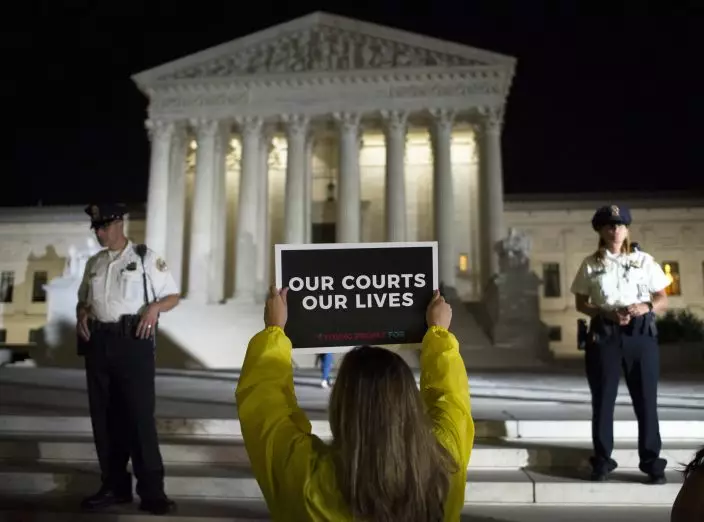
FILE - In this July 9, 2018, file photo a demonstrator protests in front of the Supreme Court in Washington. The Supreme Court term has steered clear of drama since the tumultuous confirmation of Justice Brett Kavanaugh. The next few weeks will test whether the calm can last. (AP PhotoCliff Owen, File )
Then, over the summer, Justice Anthony Kennedy's retirement meant that Trump would also get to replace the court's swing vote with a more reliable conservative. Kavanaugh's track record as an appellate judge suggested he was that man, but his confirmation was nearly derailed by allegations of sexual assault, which Kavanaugh denied.
The accusations against Kavanaugh turned the confirmation process into a national spectacle that culminated in a hearing with Kavanaugh and Christine Blasey Ford, who accused him of assault when they were in high school. Republicans said the allegation was unproven and confirmed Kavanaugh in a rare Saturday session. Spotlighting how emotional the debate had become, a crowd of demonstrators gathered at the Supreme Court building after the Kavanaugh vote, with some climbing the stone statues that line the steps.
One result of the Kavanaugh turmoil has been the most serious discussion in decades of limiting the court's powers, including possibly increasing the number of justices, Solum said. "It suggests that the legitimacy of the court is at issue now in perhaps a way it hasn't been until recently."

FILE - In this Jan. 23, 2018, file photo, immigration advocates hold a rally on Capitol Hill in Washington. The Supreme Court term has steered clear of drama since the tumultuous confirmation of Justice Brett Kavanaugh. The next few weeks will test whether the calm can last. (AP PhotoAndrew Harnik, File)
Roberts is not only the chief justice, but he has essentially taken Kennedy's place as the swing vote — the conservative justice nearest the court's center. The Supreme Court will go only as far as Roberts is willing in either direction.
He can try to keep the court entirely out of some cases, though that requires him to be able to persuade at least one other conservative justice to go along. That's what happened in the Planned Parenthood case, when Kavanaugh voted to deny review. "The difficult confirmation battle may lead to a bit of caution," said John McGinnis, a Northwestern University law school professor.
When the justices do plunge into controversy, Roberts will be able "to write or insist that decisions be narrowly drawn," McGinnis said.
Roberts has been chief justice for more than 13 years, but he is only 63 and could lead the court for an additional two decades or more. That allows Roberts, who began his legal career as a lawyer in the Reagan administration, to take a long view, McGinnis said, and await a time when political tensions and concerns about the court's reputation subside.
HAVANA (AP) — Cuban soldiers wearing white gloves marched out of a plane on Thursday carrying urns with the remains of the 32 Cuban officers killed during a stunning U.S. attack on Venezuela as trumpets and drums played solemnly at Havana's airport.
Nearby, thousands of Cubans lined one of Havana’s most iconic streets to await the bodies of colonels, lieutenants, majors and captains as the island remained under threat by the administration of U.S. President Donald Trump.
The soldiers' shoes clacked as they marched stiff-legged into the headquarters of the Ministry of the Armed Forces, next to Revolution Square, with the urns and placed them on a long table next to the pictures of those killed. Tens of thousands of people paid their respects, saluting the urns or holding their hand over their heart, many of them drenched from standing outside in a heavy downpour.
Thursday’s mass funeral was only one of a handful that the Cuban government has organized in almost half a century.
Hours earlier, state television showed images of more than a dozen wounded people described as “combatants” accompanied by Cuban Foreign Minister Bruno Rodríguez arriving Wednesday night from Venezuela. Some were in wheelchairs.
Those injured and the remains of those killed arrived as tensions grow between Cuba and the U.S., with Trump recently demanding that the Caribbean country make a deal with him before it is “too late.” He did not explain what kind of deal.
Trump also has said that Cuba will no longer live off Venezuela's money and oil. Experts warn that the abrupt end of oil shipments could be catastrophic for Cuba, which is already struggling with serious blackouts and a crumbling power grid.
Officials unfurled a massive flag at Havana's airport as President Miguel Díaz-Canel, clad in military garb as commander of Cuba's Armed Forces, stood silent next to former President Raúl Castro, with what appeared to be the relatives of those killed looking on nearby.
Cuban Interior Minister Lázaro Alberto Álvarez Casa said Venezuela was not a distant land for those killed, but a “natural extension of their homeland.”
“The enemy speaks to an audience of high-precision operations, of troops, of elites, of supremacy,” Álvarez said in apparent reference to the U.S. “We, on the other hand, speak of faces, of families who have lost a father, a son, a husband, a brother.”
Álvarez called those slain “heroes,” saying that they were an example of honor and “a lesson for those who waver.”
“We reaffirm that if this painful chapter of history has demonstrated anything, it is that imperialism may possess more sophisticated weapons; it may have immense material wealth; it may buy the minds of the wavering; but there is one thing it will never be able to buy: the dignity of the Cuban people,” he said.
Thousands of Cubans lined a street where motorcycles and military vehicles thundered by with the remains of those killed.
“They are people willing to defend their principles and values, and we must pay tribute to them,” said Carmen Gómez, a 58-year-old industrial designer, adding that she hopes no one invades given the ongoing threats.
When asked why she showed up despite the difficulties Cubans face, Gómez replied, “It’s because of the sense of patriotism that Cubans have, and that will always unite us.”
Cuba recently released the names and ranks of 32 military personnel — ranging in age from 26 to 60 — who were part of the security detail of Venezuelan President Nicolás Maduro during the raid on his residence on January 3. They included members of the Revolutionary Armed Forces and the Ministry of the Interior, the island’s two security agencies.
Cuban and Venezuelan authorities have said that the uniformed personnel were part of protection agreements between the two countries.
A demonstration was planned for Friday across from the U.S. Embassy in an open-air forum known as the Anti-Imperialist Tribune. Officials have said they expect the demonstration to be massive.
“People are upset and hurt. There’s a lot of talk on social media; but many do believe that the dead are martyrs” of a historic struggle against the United States, analyst and former diplomat Carlos Alzugaray told The Associated Press.
In October 1976, then-President Fidel Castro led a massive demonstration to bid farewell to the 73 people killed in the bombing of a Cubana de Aviación civilian flight financed by anti-revolutionary leaders in the U.S. Most of the victims were Cuban athletes.
In December 1989, officials organized “Operation Tribute” to honor the more than 2,000 Cuban combatants who died in Angola during Cuba’s participation in the war that defeated the South African army and ended the apartheid system. In October 1997, memorial services were held following the arrival of the remains of guerrilla commander Ernesto “Che” Guevara and six of his comrades, who died in 1967.
The latest mass burial is critical to honor those slain, said José Luis Piñeiro, a 60-year-old doctor who lived four years in Venezuela.
“I don’t think Trump is crazy enough to come and enter a country like this, ours, and if he does, he’s going to have to take an aspirin or some painkiller to avoid the headache he’s going to get,” Piñeiro said. “These were 32 heroes who fought him. Can you imagine an entire nation? He’s going to lose.”
A day before the remains of those killed arrived in Cuba, the U.S. announced $3 million in additional aid to help the island recover from the catastrophic Hurricane Melissa.
The first flight took off on Wednesday, and a second flight was scheduled for Friday. A commercial vessel also will deliver food and other supplies.
Jeremy Lewin, the State Department official in charge of foreign assistance, said the U.S. was working with Cuba’s Catholic Church to distribute aid.
“There’s nothing political about cans of tuna and rice and beans and pasta,” he said Thursday, warning that the Cuban government should not intervene or divert supplies. “We will be watching, and we will hold them accountable.”
Lewin said he saw no contradiction between cutting off Venezuelan oil and offering aid, saying that “the Cuban regime was taking illegitimate profits from the narco-terrorists.”
He said the U.S. hopes that delivering aid via the Catholic Church will be part of a new and broader push to deliver assistance directly to the Cuban people.
“Ultimately, the regime has to make a choice," Lewin said. “Step down or better provide towards people.”
Lewin added that “if there was no regime,” the U.S. would provide “billions and billions of dollars” in assistance, as well as investment and development: “That’s what lies on the other side of the regime for the Cuban people.”
The announcement riled Cuban Foreign Minister Bruno Rodríguez.
“The U.S. government is exploiting what appears to be a humanitarian gesture for opportunistic and politically manipulative purposes,” he said in a statement. “As a matter of principle, Cuba does not oppose assistance from governments or organizations, provided it benefits the people and the needs of those affected are not used for political gain under the guise of humanitarian aid.”
Coto contributed from San Juan, Puerto Rico.
Follow AP’s coverage of Latin America and the Caribbean at https://apnews.com/hub/latin-america
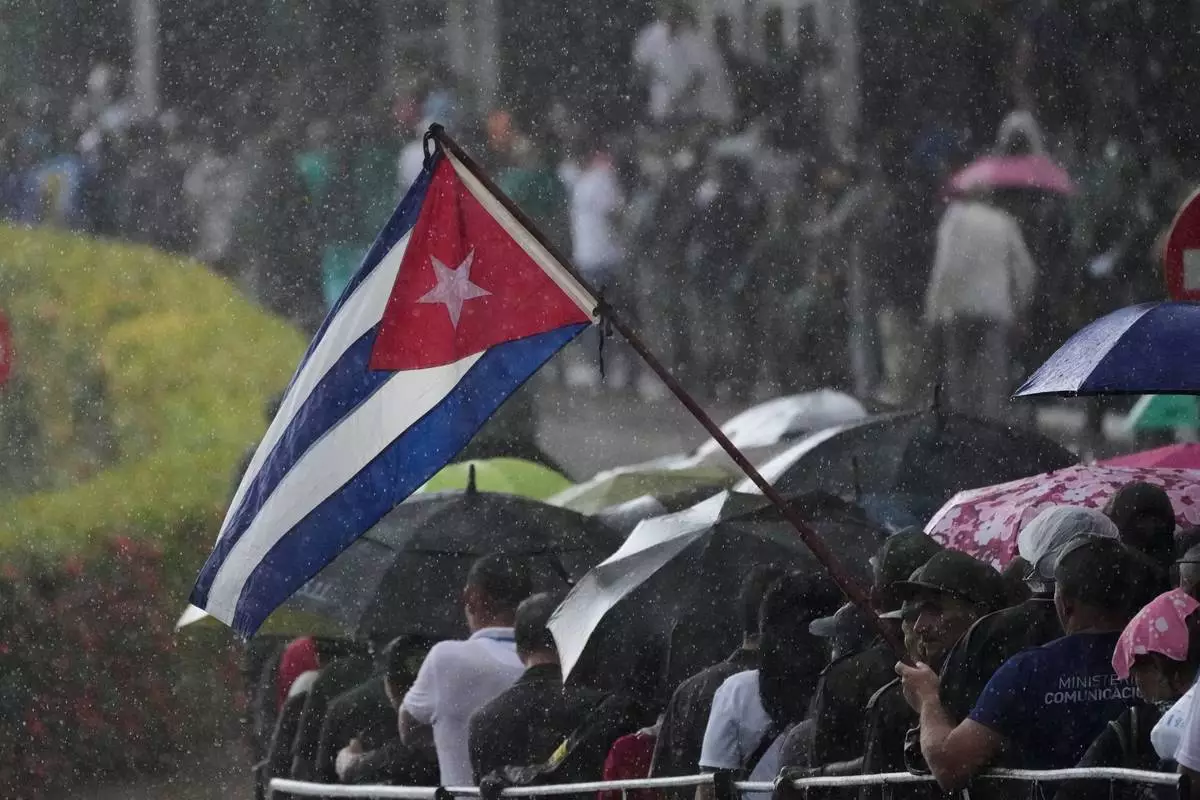
People line up outside the Ministry of the Revolutionary Armed Forces where the remains are on display of the Cuban officers who were killed during the U.S. operation in Venezuela that captured President Nicolas Maduro, as it sprinkles rain in Havana, Cuba, Thursday, Jan. 15, 2026. (AP Photo/Ramon Espinosa)
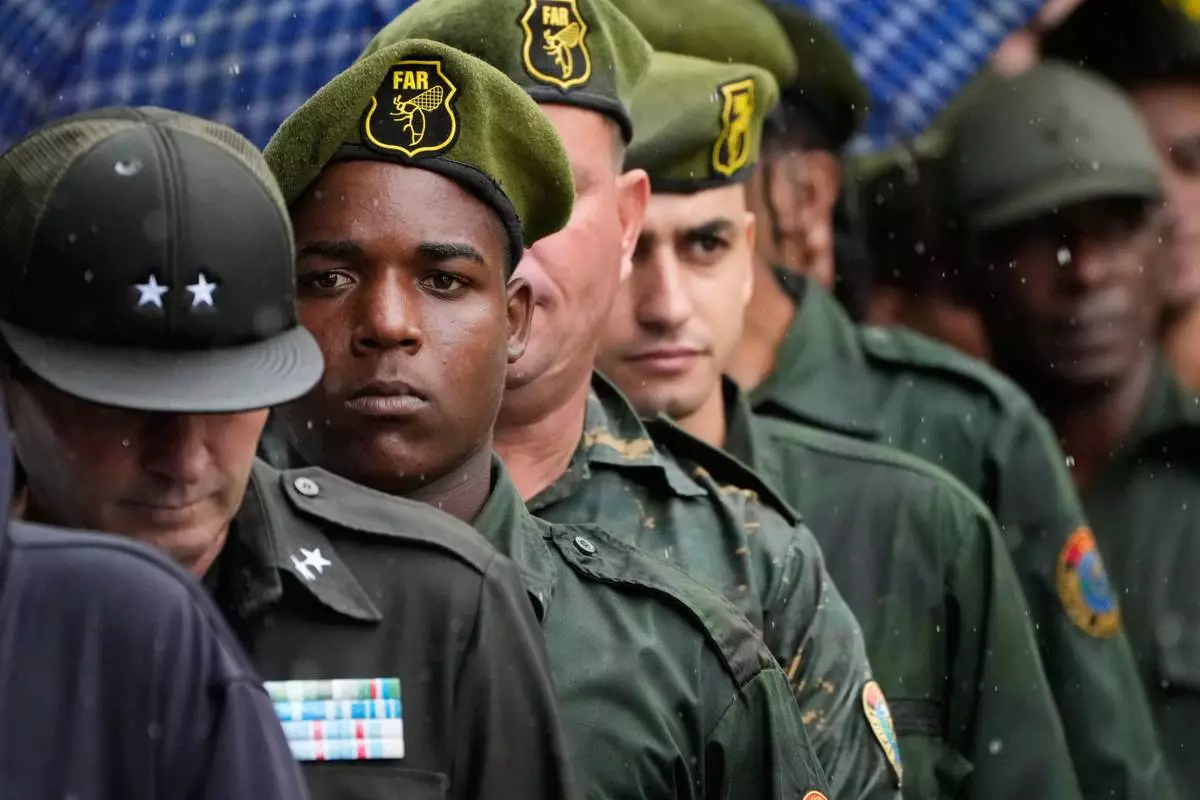
Military members line up outside the Ministry of the Revolutionary Armed Forces where the urns containing the remains of Cuban officers, killed during the U.S. operation in Venezuela that captured President Nicolas Maduro, are on display in Havana, Cuba, Thursday, Jan. 15, 2026. (AP Photo/Ramon Espinosa)

Military members pay their last respects to Cuban officers who were killed during the U.S. operation in Venezuela that captured Venezuelan President Nicolas Maduro, at the Ministry of the Revolutionary Armed Forces where the urns containing the remains are displayed during a ceremony in Havana, Cuba, Thursday, Jan. 15, 2026. (AP Photo/Ramon Espinosa)
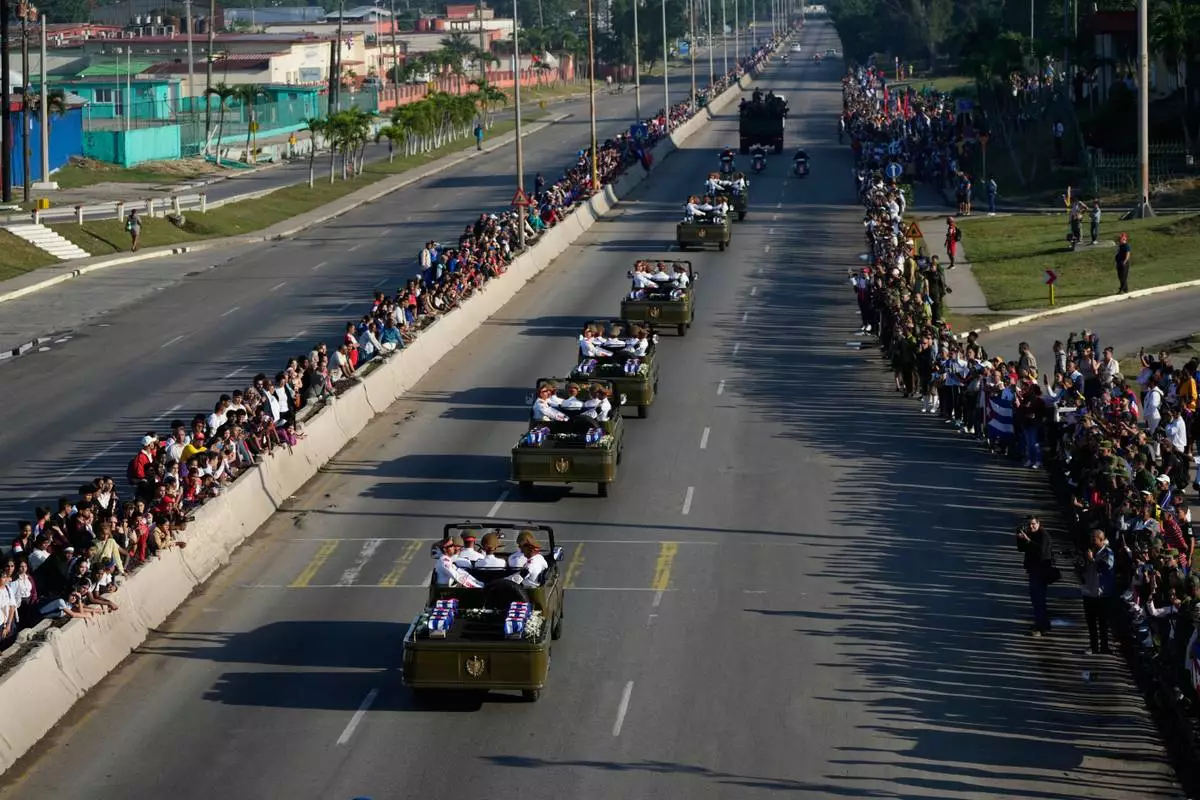
A motorcade transports urns containing the remains of Cuban officers, who were killed during the U.S. operation in Venezuela that captured Venezuelan President Nicolas Maduro, through Havana, Cuba, Thursday, Jan. 15, 2026. (AP Photo/Ramon Espinosa)

Soldiers carry urns containing the remains of Cuban officers, who were killed during the U.S. operation in Venezuela that captured Venezuelan President Nicolas Maduro, at the Ministry of the Revolutionary Armed Forces in Havana, Cuba, Thursday, Jan. 15, 2026. (Adalberto Roque /Pool Photo via AP)
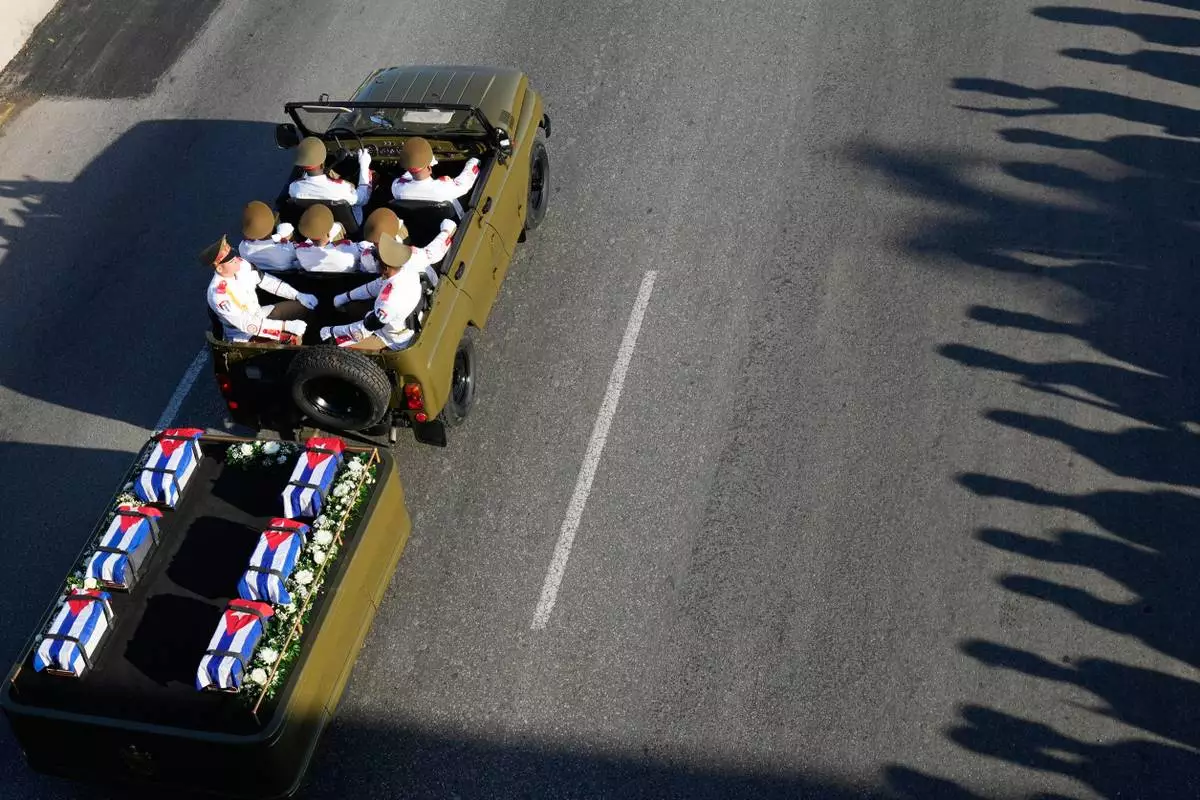
A motorcade transports urns containing the remains of Cuban officers, who were killed during the U.S. operation in Venezuela that captured Venezuelan President Nicolas Maduro, through Havana, Cuba, Thursday, Jan. 15, 2026. (AP Photo/Ramon Espinosa)
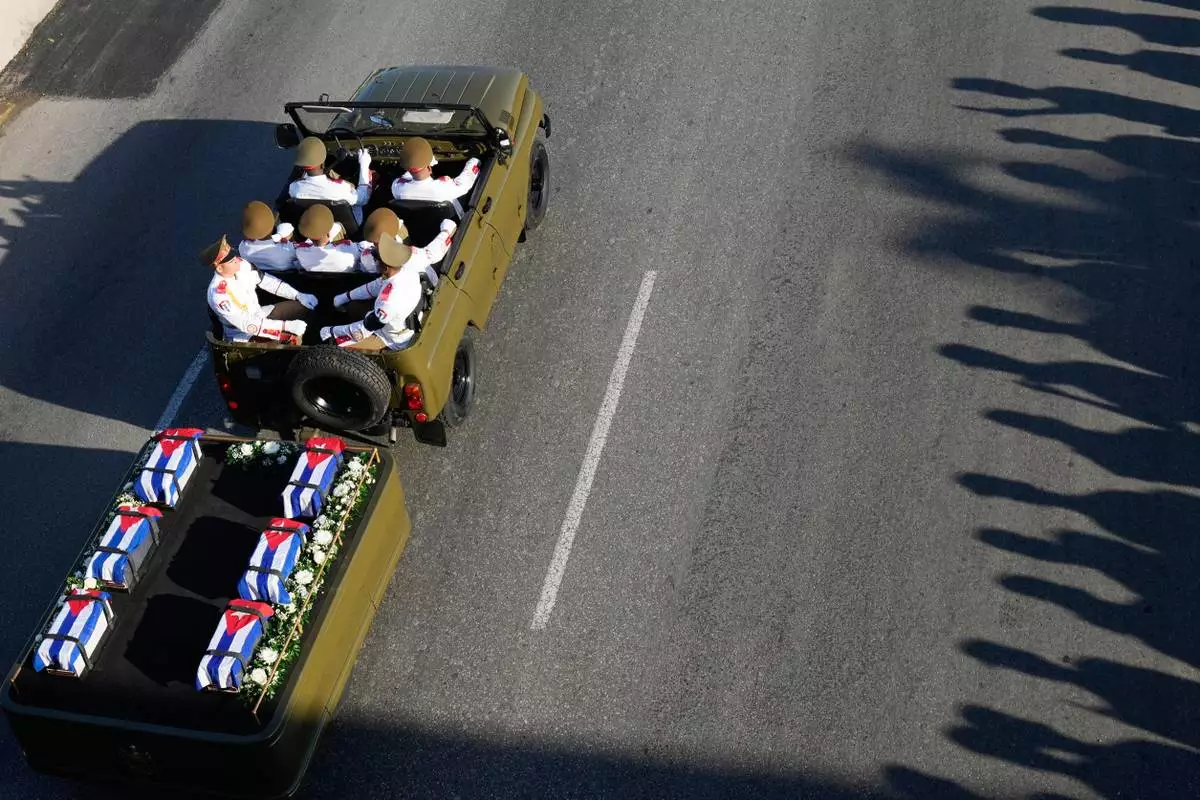
A motorcade transports urns containing the remains of Cuban officers, who were killed during the U.S. operation in Venezuela that captured Venezuelan President Nicolas Maduro, through Havana, Cuba, Thursday, Jan. 15, 2026. (AP Photo/Ramon Espinosa)
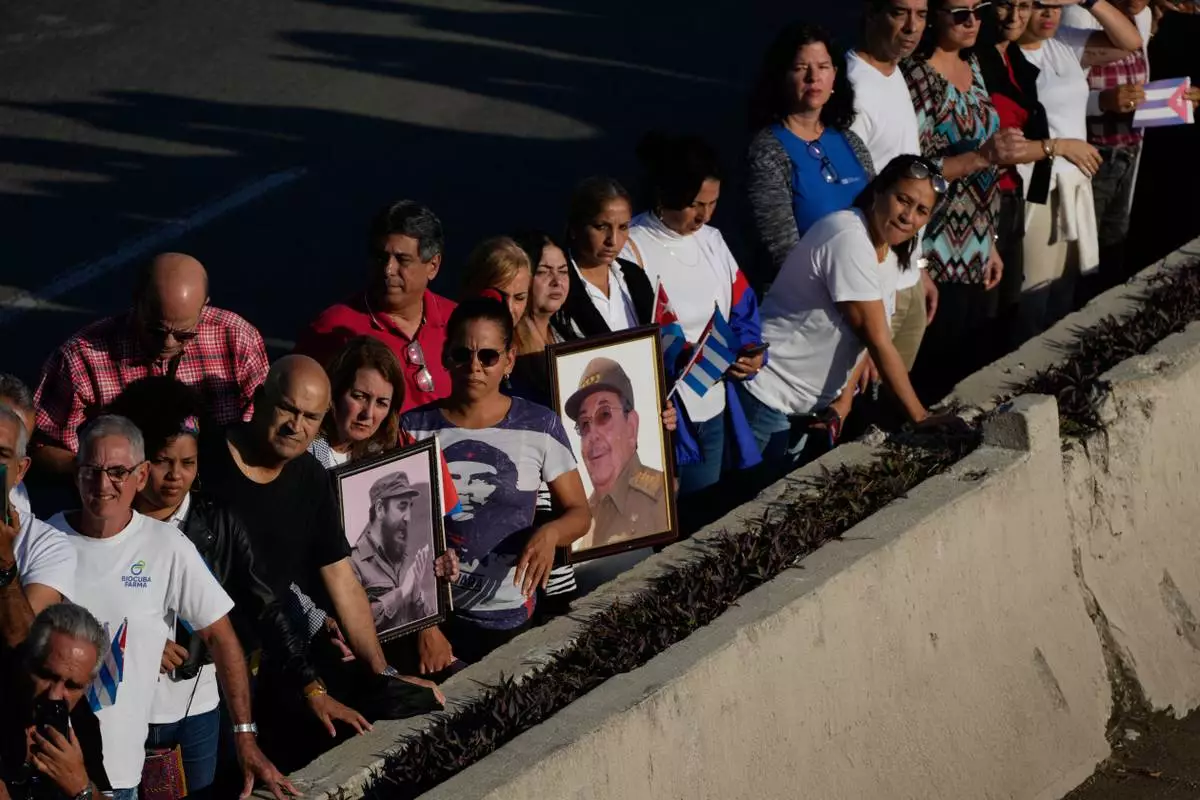
People line the streets of Havana, Cuba, Thursday, Jan. 15, 2026, to watch the motorcade carrying urns containing the remains of Cuban officers killed during the U.S. operation in Venezuela that captured Venezuelan President Nicolas Maduro. (AP Photo/Ramon Espinosa)

Workers fly the Cuban flag at half-staff at the Anti-Imperialist Tribune near the U.S. Embassy in Havana, Cuba, Monday, Jan. 5, 2026, in memory of Cubans who died two days before in Caracas, Venezuela during the capture of Venezuelan President Nicolas Maduro by U.S. forces. (AP Photo/Ramon Espinosa)



















